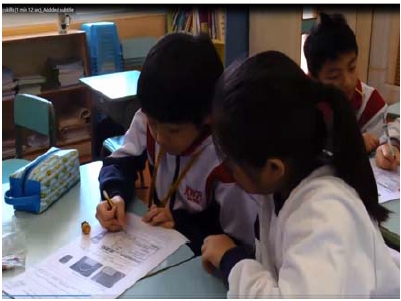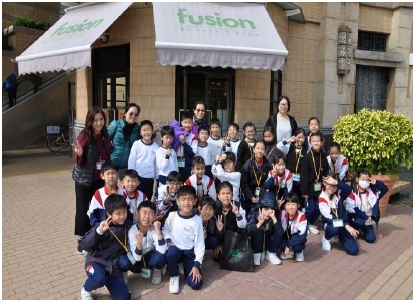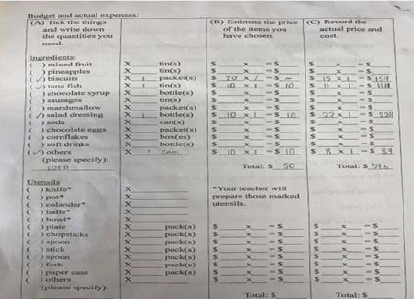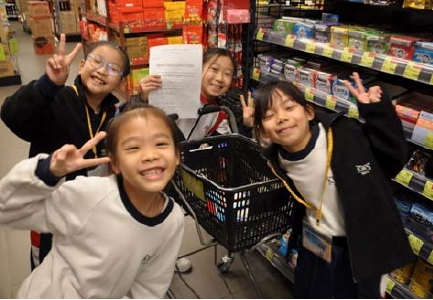Fostering the development of higher-order thinking and positive values and attitudes beyond the classroom through a cross-curricular project
Background
To address the school's major concerns about promoting higher-order thinking (HOT) and positive education among students, English Language, General Studies and Mathematics teachers of CCC Kei Wai Primary School (Ma Wan) have piloted a cross-curricular project for two years at P3, aiming at developing students' problem solving skills and a healthy lifestyle among them. Teachers hold the firm belief that making coordinated and concerted efforts can better promote Key Stage 1 students' whole-person development and prepare them for cognitively more challenging HOT tasks at Key Stage 2.
Level
P3
Strategies used
Incorporating simulated and real-life problems into the project design
English Language and content subject teachers made use of theme-related simulated and real-life problems such as preparing a budget plan as a strategy to foster students' problem solving skills. Constraints and conditions such as health concerns were incorporated into the problems for students to satisfy in order to develop basic problem solving skills.Using life-wide learning activities for students to apply classroom learning
Life-wide learning (LWL) is an effective strategy to extend and enrich students' learning experiences (The Curriculum Development Council, 2014). English Language and content subject teachers collaboratively designed life-wide and experiential learning activities such as making purchases in a supermarket for students to apply their classroom learning of the target knowledge, skills and positive values and attitudes in an authentic setting, and to solve real-life problems.Harnessing community resources
Teachers tapped into community resources as an approach to broadening students' learning experiences, horizons and learning space. English Language and content subject teachers sought assistance from a private company by arranging cashiers who are capable of speaking in English to forge a partnership so as to create a greater impact on student learning.
What happened
The following table gives an overview of the cross-curricular project design:
Theme |
Be a Smart Consumer |
||||||
Units |
|
||||||
LWL activities |
|
Stage One: Planning of the cross-curricular project At the initial stage, English Language and content subject teachers built consensus on the common focuses and laid the groundwork for the project implementation. The following shows the key tasks done at this stage:
Mapped the school English Language, General Studies and Mathematics curricula to identify common focuses
Using "Be a Smart Consumer" as a common theme, English Language, General Studies and Mathematics teachers mapped the common focuses including subject-specific vocabulary, a pre-reading strategy "THIEVES" (i.e. Title, Headings, Introduction, Every first sentence, Visuals and vocabulary, Ending and Summary), HOT and positive values and attitudes for students' whole-person development and lifelong learning. They chose relevant English Language and content subject units for cross-curricular collaboration, covering them in a synchronised manner to facilitate students to make connections across subjects.Designed a cross-curricular booklet with self-directed learning tasks
In the first pilot year, English Language, General Studies and Mathematics teachers designed a "shopping fun booklet" that includes a budget plan template and some websites for students' self-directed learning (SDL) to prepare them for the LWL activities. Students had to prepare a budget plan in groups and watch some cooking videos to learn how to cook the dishes for the food fair on their own. In the second pilot year, teachers adapted the "shopping fun booklet" and changed it to a "family cooking project booklet" for the planned parent-child activities.

Extracts of a budget plan to be completed by students prior to the visit to a supermarket
Stage Two: Implementation of the project inside the classroom English Language, General Studies and Mathematics teachers devoted concerted efforts to equipping students with the necessary knowledge, skills and positive values and attitudes needed for the project, and made explicit links between their lessons and those of other subjects. They implemented the project using an array of face-to-face and online activities inside and outside the classroom. The following shows the key tasks done inside the classroom:
Provided students with subject-specific language input to facilitate learning of the cross-curricular theme
Students were exposed to the target subject-specific vocabulary (multiply, add, expiry date, budget, price, packaging, etc.). They made use of an e-tool "Quizlet" for self-directed learning of vocabulary items before lessons. They also learnt and applied a pre-reading strategy "THIEVES" to anticipate the content of information texts in English Language and General Studies lessons.Made concerted efforts to nurture the target positive values and attitudes
To enable students to cultivate the target positive values and attitudes of smart consumers, English Language and content subject teachers joined hands to enable students to make good value judgements in buying things and to create chances for them to think about what a healthy lifestyle should be. They gave students much autonomy in making value judgements and decisions on what to buy when they went shopping.In Mathematics lessons, students first learnt how to multiply one-digit, two-digit and three-digit prices by the number of items to work out the costs. They learnt to apply multiplication skills to find out the actual cost of an item, and use facts and figures to judge whether their spending would be within the budget or not so as to become thrifty.
Students learnt the major considerations for smart shopping in General Studies lessons. Through teachers' examples and discussions, students took account of such factors as the functions and features of shopping items, and judged whether those items would be of good value for money or not. Teachers also drew students' attention to the need to spend within the given budget, and advised them to value thriftiness and resist the temptation of impulsive shopping.
English Language teachers focused on the specific tips for buying food items at a supermarket for the food fair. They taught students how to read the expiry dates and basic nutrition facts on food labels in order to choose food with less sugar, fat and/or sodium for living a healthy lifestyle. Using whole class discussions, examples and practices, students learnt to adopt the attitude of a smart consumer by avoiding shopping pitfalls such as buying unnecessary things because of alluring packaging or gifts and spending more than one's means.
Made use of theme-related simulated problems in English Language, General Studies and Mathematics lessons
To foster students' HOT, they were given simulated problems to solve in class. Through these simulated problems as shown below, they developed basic problem solving skills.Subjects
Examples of theme-related simulated problems
Mathematics
Students solved theme-related Mathematics problems in different shopping situations. They multiplied the prices with the number of shopping items to work out the total cost.
General Studies
Students solved simulated problems such as the need to choose different products to buy based on the major considerations for shopping (i.e. the functions, quality, expiry date, price of a product, given budget and healthy food).
English Language
Students needed to satisfy some given constraints/conditions (a limited budget, choosing healthy food, family members' preferences, calories of food, etc.) in simulated problems related to shopping at a virtual supermarket.
 Students solving simulated problems |
 A teacher drawing students’attention to the |
Stage Three: Implementation of the project outside the school
Provided students with real-life problems in the first pilot year
To enable students to apply problem solving skills and the target positive values and attitudes learnt in an authentic context, English Language and content subject teachers organised a visit to a supermarket for students to buy the food items and utensils for the food fair using a given budget of $60. However, the food fair was cancelled due to the COVID-19 pandemic.

Parents rendering support during the visit to the supermarket

Students looking at the food labels
Before the visit, students made use of the "shopping fun booklet" to prepare for a budget plan in groups and to estimate the cost of shopping. Using the booklet, they revisited the shopping tips explicitly taught by teachers in class. At the supermarket, they were given much learner autonomy to make different decisions and accomplish various project tasks. Students calculated the actual cost of the items and spotted possible discrepancies between the estimated and actual costs. They had to solve the problems identified by adjusting the quantities and/or choice of items to buy in order not to exceed the given budget. They also applied the shopping tips and major considerations learnt in the classroom by reading and comparing the basic nutrition facts on the food labels for a more healthy living. During the visit, they made different value judgements of whether those items would be of good value for money and good for health or not.
Teachers sought assistance from different partners. Prior to the visit, teachers requested the manager of a supermarket to arrange cashiers capable of talking with students in English on the day of the visit. Parents offered their assistance as extra manpower to escort students to the supermarket. After the visit, teachers gave a debriefing of students' shopping experience to revisit the target positive values and attitudes.
Conducted parent-child activities with real-life problems included in the second pilot year
In the second pilot year, teachers grappled with the challenge of the suspension of face-to-face classes and had much difficulty in organising similar LWL activities. They flexibly modified the visit to a supermarket and the food fair to become some parent-child activities to create equally rich experiential learning experiences for students.Students made use of the "family cooking booklet" to devise a budget plan at home before their visit to a supermarket. They chose a dish to prepare and used the websites for self-directed learning of cooking steps. Parents were tasked with the missions of accompanying their children to go shopping at a nearby supermarket and assessing their dishes served in a home party. Students also applied the shopping tips and other theme-related knowledge, skills and positive values and attitudes learnt in online lessons while they did shopping with their parents at the supermarket.
Afterwards, students cooked the dishes and enjoyed the food in a home party with family members. They also produced their cooking videos and uploaded them to the Google Classroom or YouTube for peer feedback. Using the evaluation sheets in the booklet, students' family members gave feedback on the dishes.
Some snapshots of students’ cooking
Impact
Student learning
A firm grasp of subject-specific vocabulary and pre-reading skills
With teachers' coordinated efforts to cover and consolidate theme-related vocabulary, students were able to master them well and had many opportunities for applying them in different subject contexts. They were able to apply the pre-reading strategy "THIEVES" and became more confident in understanding information texts in English Language and General Studies lessons and transferring this pre-reading strategy to other subject contexts.Basic problem solving skills developed
The majority of students were able to understand and satisfy the constraints and conditions in simulated and real-life problems and solve them. Many of them demonstrated enhanced basic problem solving skills in the project. For example, in devising a budget plan, they went through a problem solving process by first considering the major constraints: the given budget and the actual costs/prices of shopping items. They thought of different possible solutions such as re-adjusting the estimated expenditure and changing the quantities to buy and/or choices of items to resolve the real-life problems faced.
A student’s budget plan

Our little smart consumers
Enhanced self-directed learning and collaboration skills
Students displayed improved generic skills such as SDL skills and collaboration skills. At the start, they took the initiative to learn theme-related vocabulary using the e-tool "Quizlet". They displayed much learner independence by making different shopping decisions on their own and doing various SDL tasks such as working out a budget plan and learning cooking steps. This meaningful shopping experience enabled them to become less reliant upon teachers' input and gain bolstered confidence in working independently. In the first pilot year, they also showed a good team spirit when they worked closely with their peers to solve different problems encountered at the supermarket and successfully accomplished the shopping mission. There was much peer learning in the process.Target positive values and attitudes nurtured
Students were able to adopt a smart consumer's values and attitudes. They learnt to avoid some shopping pitfalls, and developed an awareness of the importance of choosing healthy food or shopping items that are of better quality or good value for money. Most of them did not yield to the temptation of buying items with appealing packaging and gifts. The authentic experience of visiting a supermarket also provided them with valuable learning points to become more frugal. As observed by their teachers and parents in the first and second years of implementation, most students were able to apply the shopping tips in an authentic setting. They have become more aware of basic nutrition facts on food labels and learnt that they should not succumb to their whims while shopping, which is pivotal for developing a healthy shopping habit.
Teacher development
Enhanced professional capacity and confidence in cross-curricular planning
English Language and content subject teachers' confidence and professional knowledge and skills in planning and implementing a cross-curricular project were enhanced. They learnt not only curriculum mapping skills but also effective ways to incorporate life-wide learning into a cross-curricular project. There was enhanced teachers' understanding and knowledge of how to play complementary roles in a cross-curricular project and conduct life-wide and experiential learning activities for students to achieve whole-person development. The pilot experience has also confirmed their belief that implementing cross-curricular projects is plausible at Key Stage 1.A more collaborative culture nurtured
Through cross-curricular planning, a collaborative culture has been nurtured at this school. English Language and content subject teachers realised that their concerted and coordinated efforts created a more significant impact on students' development of HOT and positive values and attitudes for their all-round development and lifelong learning. The successful cross-curricular collaboration has also become a catalyst for more collaboration in other levels and different aspects.
Curriculum development
This cross-curricular project was used as an entry point for conducting ongoing curriculum renewal. Different innovations including Reading across the Curriculum, self-directed learning, values education, and life-wide and experiential learning were coherently integrated into the school curriculum so as to help foster different skills including soft, life and HOT skills to tackle cognitively more challenging tasks that involve HOT at Key Stage 2, and nurture the target positive values for whole-person development. The revamped school curriculum at P3 has also become more relevant to students' lives and engaging.
Conclusion
Facilitating factors
Open-minded, creative and visionary English Language panel head and Primary School Curriculum Leader (PSCL)
The English Language panel head and PSCL are receptive to curriculum innovations. They were the masterminds of the cross-curricular project, having suggested many creative ideas to try out inside and outside the classroom and discerned the pressing needs of their students to tackle more challenging HOT tasks at the next key stage.Willingness to form a learning community to cope with the curriculum innovation
Teachers possessed limited experience in cross-curricular planning at the start. However, they were very willing to pick up new knowledge and skills quickly through a school-based workshop on planning and implementing Reading across the Curriculum and had frequent sharing in co-planning meetings that enabled collaborating teachers to form a learning circle to explore the target curriculum innovation.
Way forward
With the two-year pilot experience gained, teachers have become more ready to implement cross-curricular planning at Key Stage 1, and extend it to other levels with a view to further updating and optimising the school curriculum. As they believe that HOT and positive values and attitudes are the cornerstones of students' whole-person development, they have begun and will continue to focus more on other lifelong learning skills such as developing creativity and an aesthetic sense among students for their whole-person development.
Bibliography
Curriculum Development Council. (2014). Basic Education Curriculum Guide – To Sustain, Deepen and Focus on Learning to Learn (Primary 1 - 6). Hong Kong: Author.
CCC Kei Wai Primary School (Ma Wan)
Amy POON (Language Support Officer)